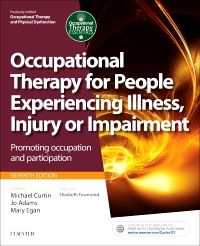Preface
Foreword
Contributors List
Section 1: Introduction
Chapter 1 - Evolution of occupational therapy within the health care context (Michael Curtin, Jo Adams and Mary Egan)
Section 2: Underpinning sciences
Chapter 2 - Occupational science (Debbie Laliberte Rudman, Rebecca Aldrich)
Chapter 3 - Biomedical sciences (Lesley Collier, Richard Collier)
Chapter 4 - Social sciences (Judith Pettigrew, Katie Robinson)
Section 3: Professional reasoning
Chapter 5 - Client-centredness (Jacquie Ripat)
Chapter 6 - Communication in occupational Therapy practice (Sue Baptiste)
Chapter 7 - Professional reasoning in occupational therapy practice (Carolyn Anne Unsworth)
Chapter 8 - Canadian practice process framework (Noemi Cantin, Martine Brousseau)
Chapter 9 - Occupational therapy practice models (Merrill Turpin)
Chapter 10 - Occupational performance model (Australia): a description of constructs, structure and propositions (Chris Chapparo, Judy L. Ranka, Melissa Therese Nott)
Chapter 11 - The Canadian model of occupational performance and engagement (cmop-e) (Jane A. Davis)
Section 4: Assessment
Chapter 12 - Process of assessment (Clare Hocking, Karen Whalley Hammell)
Chapter 13 - Canadian occupational performance measure (Heather Colquhoun, Anne W. Hunt and Janet F. Murchison)
Chapter 14 - Task, activity and occupational analysis (Cynthia Perlman, Melanie Bergthorson)
Chapter 15 - Dynamic performance analysis (Rose Martini, Dorothy Kessler)
Chapter 16 - Analysis of occupational performance: motor, process and social interaction skills (Gill Chard, Sue Mesa)
Chapter 17 - Perceive, recall, plan and perform (prpp) system of task analysis and intervention (Chris Chapparo, Judy L. Ranka and Melissa Therese Nott)
Chapter 18 - Assessing the environment (Gunilla Carlsson, Agneta Malmgren Ange)
Chapter 19 - Reasoning underpinning assessments for people experiencing neurological conditions (Mary Egan, Lise Zakutney)
Chapter 20 - Reasoning underpinning assessments for people experiencing musculoskeletal conditions (Tanja A. Stamm, Stefanie Haider, Simone Luschin and Agnes Sturma)
Chapter 21 - Reasoning underpinning assessments for people experiencing medical conditions and conditions requiring surgery (Deidre Morgan, Celia Marston and Jenni Bourke)
Section 5: Goals
Chapter 22 - Writing occupation-focused goals (Julia Bowman, Lise Mogensen and Natasha A. Lannin)
Section 6: Enabling skills and strategies
Chapter 23 - Overview of enabling skills and strategies (Michael Curtin)
Chapter 24 - Advocacy and lobbying (Valmae Rose, Kevin Cocks and Lesley Chenoweth)
Chapter 25 – Education (Tammy Hoffmann, Sally Eames)
Chapter 26 - Public health (Rachael Dixey)
Chapter 27 - Community development (Marie Grandisson, Anick Sauvageau)
Chapter 28 - Community-based rehabilitation (Kirsty Thompson, Christina L. Parasyn, Briana Wilson and Beth Sprunt)
Chapter 29 – Coaching (Wendy Pentland, Amy Heinz, Jeanette Isaacs-Young and Jen Gash)
Chapter 30 - Psychosocial support (Jacqueline Mckenna)
Chapter 31 - Working with groups (Claire Craig)
Chapter 32 - Enabling sexuality (Narelle Higson)
Chapter 33 - Personal care (Helen Van Huet, Tracey Elizabeth Parnell and Virginia Mitsch)
Chapter 34 – Leisure (Ruth Squire, Lucia Ramsey and Carolyn Dunford)
Chapter 35 – Work (Yeliz Prior, Alison Hammond)
Chapter 36 - Biomechanical strategies (Hanif Farhan Mohd Rasdi)
Chapter 37 - Hand therapy (Kathy Whalley, Sarah Bradley and Jo Adams)
Chapter 38 - Orthotics
(Natasha A. Lannin, Iona Novak and Michelle Jackman)
Chapter 39 - Working with people living with vision impairment (Alexandra Lonsdale, Carlia Rix and Kirsty Stewart)
Chapter 40 - Optimising motor performance and sensation after brain impairment
(Annie Mccluskey, Natasha A. Lannin, Karl Schurr and Simone Dorsch)
Chapter 41 - Cognitive and perceptual strategies (Carolyn Anne Unsworth)
Chapter 42 - Cognitive orientation to daily occupational performance
(Helene J. Polatajko, Sara E. Mcewen, Deirdre R. Dawson and Elizabeth R. Skidmore)
Chapter 43 - Assistive technology (Natasha A. Layton)
Chapter 44 - Universal design (Sharon Joines, Andrew Payne)
Chapter 45 - Home modification (Catherine E. Bridge, Phillippa Carnemolla)
Chapter 46 – Mobility (Kristy M. Robson)
Chapter 47 - Wheeled mobility and seating systems (Rachael Leigh Mcdonald)
Chapter 48 - Driving and community mobility (Marilyn Di Stefano)
Chapter 49 - Moving and handling (Tess Whitehead)
Section 7: Reflecting on practice
Chapter 50 - Reflecting on practice (Genevieve P. Epin)
Http://EVOLVE.ELSEVIER.COM/curtin/ot
Reflecting on practice – excerpts from bonus practice stories
Mrs Tremblay: A practice story of a person experiencing rehabilitation following a
stroke - reflecting on practice (Dorothy Kessler, Katrine Sauve-Shenk, Valerie Metcalfe)
Karin: A practice story of a person experiencing rheumatoid arthritis - reflecting on practice (Mathilda Bjork, Ingrid Thyberg)
Angela: A practice story of a person experiencing palliative care – reflecting on practice (Deidre Morgan, Celia Marston)


